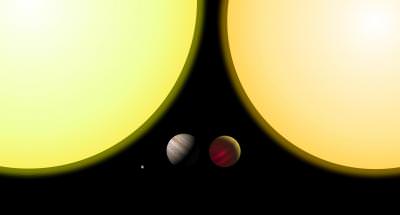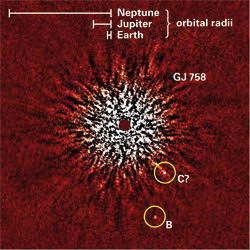Yet another planet outside of our Solar System has been directly imaged, bumping the list up past ten. Given that the first visible light image of an extrasolar planet was taken a little more than a year ago, the list is growing pretty fast. The newest one, planet GJ 758 B is also the coolest directly imaged planet, measuring 600 degrees Kelvin, and it orbits a star that is much like our own Sun. GJ 758 B has a mass of between 10-40 times that of Jupiter, making it either a really big planet or a small brown dwarf.
Unlike many of the other directly imaged planets, GJ 758 B resides in a system remarkably like our own Solar System – the star at the center is Sun-like, and the orbit of the planet is at least the same distance from its star as Neptune is from our own. Current observations put the distance at 29 astronomical units.
“The discovery of GJ 758 B, an extrasolar planet or brown dwarf orbiting a star that is similar to our own sun, gives us an insight into the diversity of substellar objects that may form around Solar-type stars,” said Dr. Joseph Carson, from the Max Planck Institute for Astronomy. “This in turn helps show how our own Solar system, and the environments that are conducive to life, are just one of many scenarios that may be the outcome of planet or brown dwarf formation around Sun-like stars.”
Another object, labeled “C?” in the image above, could potentially be another companion to the star. Further observations will be required to determine whether the object in fact orbits the star or is merely another star in the background of the image which is not part of the system.
The mass of the star still has yet to be exactly determined, thus the 10-40 Jupiter mass range. It is 600 degrees Kelvin, which corresponds to 326 Celsius and 620 Fahrenheit, about the hottest temperature that a conventional oven can reach. Though this may seem hot, it’s actually pretty cool for an extrasolar planet. Even though it is so far away from its Sun that, like Neptune, it receives very little warmth from the star it orbits, GJ 758 B is in a stage of formation where the contraction of the planet due to gravity is converted into heat.

Dr. Markus Janson from the University of Toronto, a co-author of the paper announcing the imaging, said, “This is also why the mass of the companion is not well known: The measured infrared brightness could come from a 700 million year old planet of 10 Jupiter masses just as well as from a 8700 million year old companion of 40 Jupiter masses.” The paper detailing the results will be published in Astrophysical Journal Letters, but is available here on Arxiv.
The planet was imaged using the Subaru Telescope’s new High Contrast Instrument for the Subaru next generation Adaptive Optics (HiCIAO) instrument, which utilizes the technology of adaptive optics to eliminate the interference of our atmosphere that blurs images in ground-based telescopes. The imaging of GJ 758 B is part of the commissioning run of the HiCIAO instrument, which plans to take a larger survey to detect extrasolar planets and circumstellar disks in the next five years.


That would really be cool, but the latest thinking is that detecting the spectra of Earth-like planets for signs of ET life are, sadly, orders of magnitude more difficult than what’s been achieved so far. That’s not to say it won’t be possible one day — I have a lot of confidence that astronomers will continue to find novel ways to achieve what was once thought impossible, but I don’t think this is going to happen in the next few years. Maybe 15 – 20 years.
Very cool! Hopefully within a few years we’ll be taking spectra of LOTS of planets!
I keep thinking about when I was a kid in the 1980’s and going to astronomy meetings with my Dad and people still talking about how our solar system may be a rare fluke. We’ve known about extrasolar planets for almost 20 years now!
These kind of advances (first, extrasolar planet detection and now direct imaging) have been a source of joy and wonderment for me. I honestly never thought that we would image such a planet in my lifetime.
” Hopefully within a few years we’ll be taking spectra of LOTS of planets!”
Amen! That’s when we’ll wake up one day to find an announcement that direct signs of extraterrestrial life has been detected.
Just one bone to pick:
According to Wikipedia — Kelvin (Usage conventions) — prior to the 13th General Conference on Weights and Measures (CGPM) in 1967–1968, the unit kelvin was called a “degree”, the same as with the other temperature scales at the time. It was distinguished from the other scales with either the adjective suffix “Kelvin” (“degree Kelvin”) or with “absolute” (“degree absolute”) and its symbol was °K. Before the 13th CGPM, the plural form was “degrees absolute”. The 13th CGPM changed the name to simply “kelvin” (symbol K). The omission of “degree” indicates that it is not relative to an arbitrary reference point like the Celsius and Fahrenheit scales — both of which should have the adjective prefix “degrees” — but rather an absolute unit of measure which can be manipulated algebraically; e.g., multiplied by two to indicate twice the amount of “mean energy” available among elementary degrees of freedom of the system.
Erratum:
I need some sleep!
A great find! The grammar police seem to be getting a bit to picky on this one.
Is it ten already? We now have imaged more exoplanets than planets – this is how it should be.
This isn’t grammar, this is important. 😀
More precisely, it’s standards.
The target for grammar, as a language construct, is generally to increase redundancy so that you can make errors. And still be understood. (Except by redundant grammar cops, of course. (o.O))
The target for standards, as a technical construct, is always to decrease redundancy. More precisely here so that you can’t make errors.
For example, kelvin is distinguished from Kelvin to avoid confusion, while the shorthand K is used to honor the person. (And so you can avoid confusing a unit, K, with a prefix, k (kilo).)